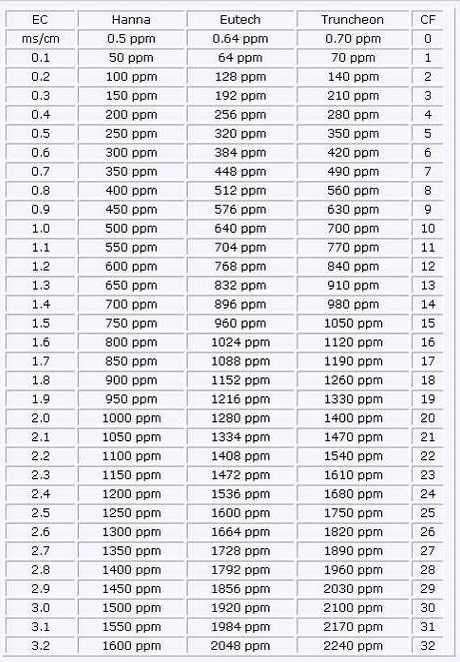*New addition, compliments of Arty-Zan 
>>> An interesting bit on why use EC over TDS (500 scale)
EC vs. TDS
A quick answer to why we should use EC instead of TDS
The debate over EC and TDS has been an ongoing issue for a long time. These two measurements are used to determine the strength of hydroponic solution. Although they are widely used they should only be used as a guideline and you should always follow mixing instructions on the label of you nutrient.
EC stands for Electrical Conductivity and is measured in mS/cm or millisiemens per centimeter. TDS stands for Total Dissolved Solids and is measured in PPM or parts per million. TDS is acquired by taking the EC value and performing a calculation to determine the TDS value. Because TDS is actually a calculation it is really only a guess at what the nutrient concentration is. On top of that, there are three different conversion factors to determine TDS and different manufacturers use different conversion factors. In other words you could test the same solution with two different meters and get two totally different readings. But the EC is read the same by all meters the only difference is the conversion factor.
Some additional information for the geeks like us
First of all lets talk about the differences and similarities between EC and TDS. We all know that they are both a measure of the amount of dissolved solids in your nutrient solution. This measurement is used by growers to get an idea of how much nutrient is present in the solution. By maintaining the correct level of nutrients in the solution your plants will achieve maximum results. This all sounds very important but there are some major differences between the different meter manufacturers. Some of you may have noticed that some calibration solutions that are marked to read at a certain TDS may actually read different from meter to meter. This is where the problem begins.
Some of you may have not even heard of EC and others may have heard of it but do not even know what it is. Unfortunately many growers in the United States have become very accustomed to using the TDS scale while in most other countries, including Europe, they don't use anything but EC. The fact is that TDS is actually a result of a calculation from EC. The problem is lack of consistency among manufacturers when it comes to conversion factors. This is where it may get a little confusing. Most meter manufacturers in the hydroponics industry use one of two conversions. There is the 442 conversion (40% sodium sulfate, 40% sodium bicarbonate, and 20% sodium chloride) which some say is the closest thing to a hydroponic solution. The
442 conversion is approximately 700 x EC in millisiemens (mS). Then there is the NaCl conversion (sodium chloride) which others say is the closest thing to a hydroponic solution. The
NaCl conversion is approximately 500 x EC in millisiemens (mS). You can see where the confusion comes from because the same solution will read 2100 ppm on one meter and it will read 1500 ppm on the other. That is a difference of 600 ppm which as many of you know could be devastating. Both meters are functioning correctly they are just calculating the TDS using a different formula. So, if you do not calibrate your meter using the correct calibration solution your meter could give you a very inaccurate reading.
The solution is simple, use EC. With EC, no conversion is required so all meters will read the same regardless of the manufacturer.
Here is a chart showing some sample measurements:
| mS | µS | NaCl Conv. | 442 Conv. |
|---|
| 1.0 mS | 1000 µS | 500 ppm | 700 ppm |
| 1.5 mS | 1500 µS | 750 ppm | 1050 ppm |
| 2.0 mS | 2000 µS | 1000 ppm | 1400 ppm |
| 2.5 mS | 2500 µS | 1250 ppm | 1750 ppm |
| 3.0 mS | 3000 µS | 1500 ppm | 2100 ppm |
And this for quick reference....
Meter scales
Blue Lab = 500 which also calculates 700 scale
Milwaukee = 500 scale
Hanna = 700 scale
Oakton = 700 scale
TDS is 500 scale but displays it as
Different nutrient manufacturers also use different scales
When advising the PPM to use, yet another pit fall.
Nutrient Manufacturer = Scale
Advanced Nutrients=700 scale
Botanicare=700 scale
CES/Cutting Edge Solutions=500 scale
Dutch Master=500 scale
Dyna-Gro=500 scale
FoxFarm=700 scale using dechlorinated tap water
General Hydroponics =500 scale using reverse osmosis water
General Organics =500 scale using reverse osmosis water
House & Garden =700 scale
Humboldt Nutrients=500 scale
Hydro Organics/
Earth Juice =500 scale
Nectar for the Gods=700 scale
Rock Nutrients=700 scale
Roots Organics=500 scale
Rx Green Solutions=500 scale using distilled water
Soul=500 scale
Technaflora =500 scale
 CC'd from hydro... compliments of Grey Bear!
CC'd from hydro... compliments of Grey Bear! 


